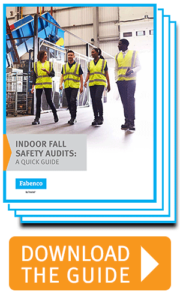
The 7th Annual Safety Stand-Down to Prevent Falls was September 14-18, 2020. Like so many events this year, it was postponed from its original date due to the spread of COVID-19. Even with a major pandemic on our hands, fall safety is still a major health concern. To help keep fall protection at the top of our minds, OSHA encouraged employers to provide stand-downs of their own. This however can be done at any time.
What does this mean? Since large public fall prevention training events are currently not possible, instead, companies can hold their own trainings within their premises while upholding appropriate social distancing measures. And with the widely available online resources, employers can also get creative with virtual trainings and video infographics to ensure workers in all the 50 states keep fall protection a priority and stay on top of the latest regulations.
What Is the Safety Stand-Down and why participate?
A safety stand-down is a voluntary event that presents employers an opportunity to talk directly with employees about safety. While any workplace can hold a stand-down, fall safety is a major concern in construction, manufacturing, and general industries. Industries where fall hazards aren’t present can still use this opportunity to have a conversation with employees about other job hazards they may face, as well as protective methods and PPE, and the company’s safety policies and goals.
It can also be an opportunity for employees to talk to management about the fall and other job hazards they see in an open and honest forum. Safety stand-downs not only advance and refresh your employees’ safety skill set, they’re also a part of building a larger culture of safety, respect, and team morale. Participating companies will also receive a certification of completion, letting clients, customers, and current and future employees know that safety is both valued and a priority.
How to Plan a Successful Safety Stand-Down

- Take a moment and review the basics on OSHA’s official stand down site.
- Gather your resources.
- Review your company’s current fall protection program to identify if it covers all types of falls.
- Inspect your equipment, checking self-retracting lifelines, harnesses, and safety nets for cut or torn fiber, safety lanyards for unusual wear patterns, ladders and guardrails for wear and tear, and self-closing gates for distortions, damage and general wear.
- Have your workers complete the OSHA training: either an updated training for existing workers or a full training program for new employees.
- Develop hands-on activities such as regular equipment checks and personal fall arrest and fall protection system demonstrations to increase engagement and information retention.
- Encourage active employee participation with discussions on the safety areas of their concern.
A Word on OSHA Standards and Guidelines
OSHA has industry-specific requirements and tools to reduce the fall hazards associated with working at elevated heights. OSHA standards and policy guidelines also offer federal register notices, directives, preambles to final rules, letters of interpretation, and national consensus standards regarding fall hazards and protection measures. These topics can be difficult to interpret, and it’s up to you to make sure you and your employees fully understand them. For this reason, it’s helpful to partner with a reputable fall safety equipment company that will help you find the right solution for the job at hand.
For now, let’s review the basics:
Guardrails and Handrail systems
Guardrail systems are barriers erected to prevent workers from falling to lower levels. They include top rails, mid-rails, and posts, and should be elevated at 42 inches above the working area. If guardrails are used in sites where holes are the access point to the working area, self-closing gates must be used to prevent workers from walking straight into the hole.
Where appropriate, roof tops, elevated walkways, ladders, roof hatches, mezzanines, loading docks, and machinery need to be guarded and protected. That means using guardrails, self-closing gates, and specifically-designed guards to limit access and prevent falls.
Toe Boards
Toe boards are used as barriers at the base of the working area aimed at protecting an employee’s feet from slipping over an edge or prevent tools from falling. They must be at least 4-inches high and securely fastened with no more than a quarter-inch clearance above the floor level. The toe boards must be capable of withstanding a force of up to 50 pounds without failure either in an upward or downward direction. Toe boards, when used on a bridge, should remain unobstructed and workers are expected to have additional safety lanyards for added safety.
Personal Fall Arrest Systems
Personal fall arrest systems are designed to halt the process of a fall as it is happening, and absorb the energy built up in a fall. These systems are comprised of a full body harness, connectors ie: lanyard or self retracting lifeline, anchorage, and rescue. It is important to note that OSHA does not consider body belts as part of the personal safety harness system and should not be used as such.
Personal Fall Restraint Systems
Like fall arrest systems, a personal fall restraint system consists of a safety harness, connectors and anchorage. However, instead of arresting a fall, they restrain your employees from ever having a fall in the first place by restricting an employee’s movement in dangerous areas. Essentially not allowing the employee near any unprotected side or edge.
Safety Net Systems
If appropriate, a safety net system can be utilized, but keep in mind, they have very specific uses and rules. It’s smart to refer to OSHA’s safety net rules each and every time you consider using one, as the parameters are different from worksite to worksite.
The Safety Stand-Down is in Your Hands
You already know that the success of a company lies in its employees. That’s exactly why keeping yours healthy, happy, and productive, should remain your top priority. For more safety news, updates, and info, stay up to date with Fabenco and check out our blog here.




